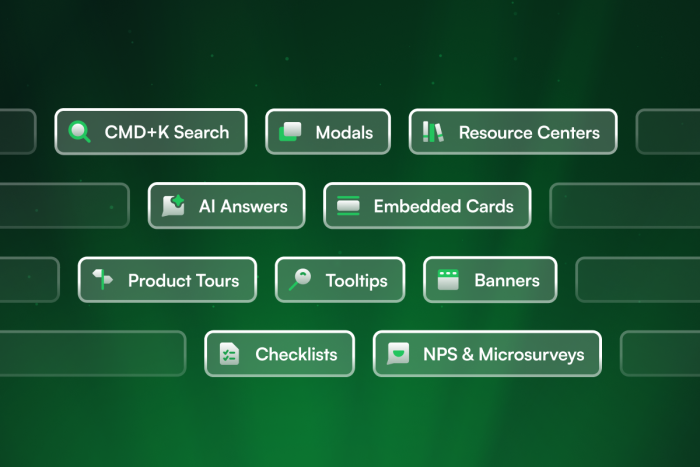What are Digital Adoption Platforms?
Imagine being able to create software without writing code; to create targeted user experiences that teach, guide, nudge, signpost, and motivate your users to discover more value in your product... welcome to the world of Digital Adoption Platforms (or DAPs, as we’ll refer to them in this guide).
Digital Adoption Platforms are software platforms that allow you to create, deploy, analyze, and improve in-product user experiences without needing ongoing engineering or development work.
These can take the form of a variety of UX patterns include modals, banners, walkthroughs, checklists, microsurveys (e.g. NPS), cards, hotspots, badges, tooltips, and more.

Some of the UX patterns available within DAPs
Here’s how they work:
- 1 You perform a one-time code installation, to include the DAP code snippet into your application, and send user information (ID and other attributes, and/or events)
- 2 You use the DAP Builder to create your content (choosing the pattern, setting the styling, adding the copy, configuring the conditions to show, setting the target audience etc.)
- 3 You can deploy (publish) directly through the DAP without any engineering involvement. Monitor, analyze collected data, make changes etc. all without coding.
By employing a DAP you can give control of this whole process to use targeted in-app experiences to non-engineering teams (e.g. Product, Product Growth, Product Marketing, Design etc.) and build up your series of campaigns to drive user engagement.
DAPs automatically collect analytics (e.g. who saw or engaged with your user experiences) thereby allowing you to measure success and integrate this data with other tools in your tech stack through APIs and integrations.
You’ll likely have heard of digital adoption platforms before—common tools include: Appcues; Chameleon; CommandBar; Pendo; Userflow; Userpilot; WalkMe; Whatfix. Each has its strengths and weaknesses, and we'll cover this in "The DAP Market and Category" section of this guide.
One of the challenges in this category (since it is new and can help businesses in many ways) is the lack of consistency in terminology and a widely accepted naming convention. DAPs are sometimes also referred to as:
Product Adoption Platforms
User Onboarding Software
Feature Announcement Tools
In-App Experience Solutions
We will talk about Digital Adoption Platforms because this category name is popular with Gartner and G2 when describing this category, but here at Chameleon, we usually refer to ourselves as a Product Adoption Platform.